Good Class Bungalow Singapore The Ultimate Guide
Explore the ultimate guide to the good class bungalow Singapore market. Discover exclusive locations, investment potential, and ownership rules.
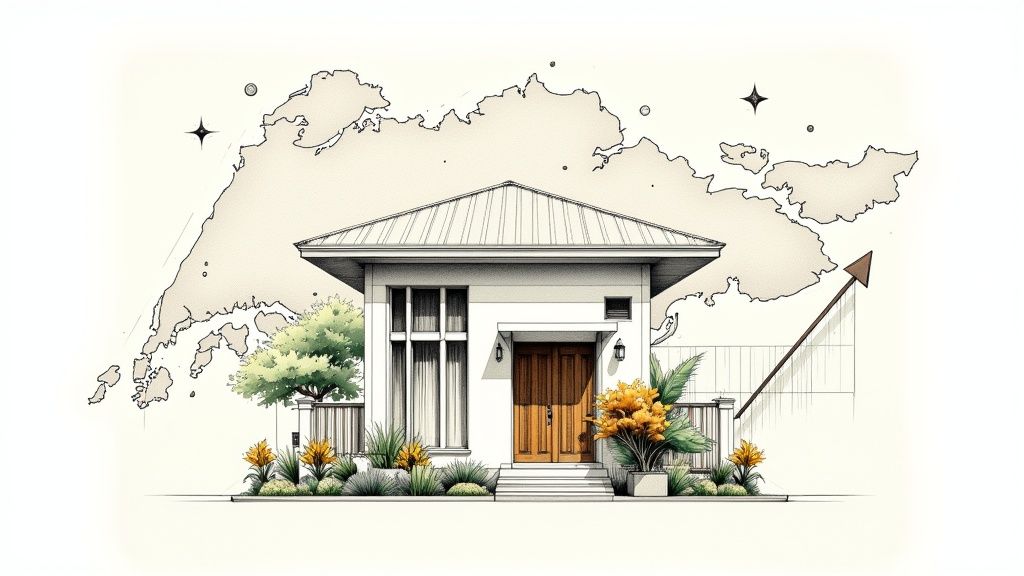
When people talk about a Good Class Bungalow in Singapore, they aren't just talking about a big house. They're referring to the absolute zenith of the country's property market—an elite tier of real estate defined by a strict set of government rules.
Think of it less as a property type and more as an exclusive club, one defined by sprawling land, a prestigious address, and sheer rarity.
What Exactly Makes a Good Class Bungalow (GCB) a GCB?
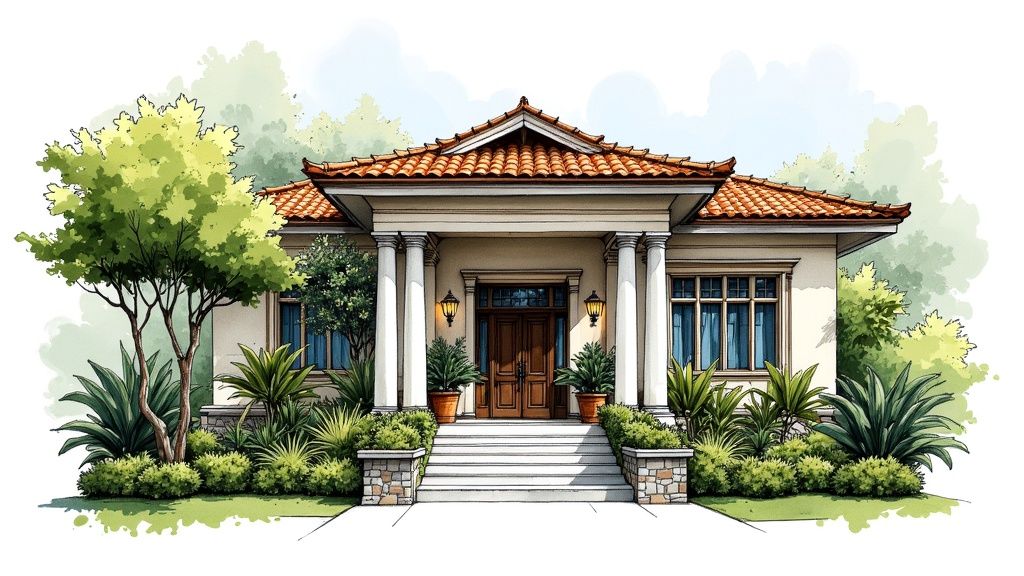
Picture owning what feels like a private nature reserve right in the heart of one of the world's densest cities. That’s the feeling a Good Class Bungalow (GCB) evokes. These are not just stunning homes; they are a unique asset class, meticulously controlled by Singapore's Urban Redevelopment Authority (URA).
The whole idea behind the GCB designation is to protect the low-density character and lush greenery of Singapore's most historic and prestigious residential areas. This careful planning prevents the kind of high-rise development you see everywhere else, guaranteeing these enclaves remain quiet, spacious, and exclusive.
In that sense, buying a good class bungalow in Singapore is less like purchasing a home and more like becoming the custodian of a piece of the country’s heritage.
The Ironclad Rules That Define a GCB
To carry the official GCB title, a property has to tick several non-negotiable boxes. These aren't just suggestions; they are firm regulations that create a protective barrier around this asset class.
The table below breaks down the must-have criteria that every GCB must meet.
Key Characteristics of a Singapore Good Class Bungalow
| Criterion | Specification | Significance |
|---|---|---|
| Minimum Land Area | Must be at least 1,400 square metres (approx. 15,070 square feet). | This foundational rule immediately separates GCBs from all other landed properties, ensuring a vast, private estate. |
| Gazetted Location | Must be situated within one of the 39 designated GCB Areas (GCBAs). | These prime locations, like Nassim Road or Cluny Park, are protected, ensuring the neighbourhood's prestige and character. |
| Site Coverage | The bungalow's structure cannot exceed 40% of the total land area. | This regulation guarantees expansive gardens, lawns, and open spaces, preserving the low-density, green environment. |
| Building Height | Limited to a maximum of 2 storeys (plus an attic and basement). | This prevents towering structures, maintaining the area's tranquil, spacious feel and unobstructed views. |
These strict criteria work together to forge an environment of unparalleled exclusivity and privacy, which is the very essence of the GCB lifestyle.
Because of these strict rules, the number of GCBs is effectively capped. There are only about 2,800 of these plots in the entire country, a finite number that makes them incredibly sought-after as legacy assets.
Scarcity Is the Ultimate Luxury
This extreme, built-in rarity is what truly fuels their prestige and sky-high valuations. In a city-state that is constantly building higher and denser, the GCB stands as a powerful symbol of protected space, privacy, and enduring wealth.
It's a unique marriage of deliberate government preservation and private ownership, making it the undisputed trophy asset in Singapore's real estate crown.
A Look Back: The Story Behind Singapore's Most Prestigious Homes
Good Class Bungalows weren't just created overnight. Their story is a fascinating part of Singapore's own journey, tracking its evolution from a colonial trading hub to the meticulously planned global city we know today. To understand their history is to understand why owning a good class bungalow in Singapore is like owning a piece of the nation’s heritage.
It all started back in the colonial days of the 19th and early 20th centuries. Wealthy merchants and high-ranking British officials acquired huge plots of land, many of which were once plantations for rubber or nutmeg. On this land, they built grand, sprawling estates that were unmistakable symbols of their wealth and influence.
These early bungalows were masterfully designed for the tropical heat. Think wide verandas, soaring ceilings, and expansive gardens that provided a cool escape from the dense city. They unknowingly set the standard for the low-density, high-prestige living that now defines certain corners of the island.
A Pivotal Moment in Urban Planning
The real turning point, however, came much later. As Singapore urbanized at a breathtaking pace after independence, the government saw a pressing need to shield these unique residential areas from the encroachment of high-rise buildings. This was a crucial piece of foresight, aimed at preserving the island's green lungs and ensuring a high quality of life even as the city grew upwards.
This led to a landmark moment for the nation's urban planners. The concept of the Good Class Bungalow was officially cemented in the 1980 Revised Master Plan. The Urban Redevelopment Authority (URA) identified and gazetted 39 specific Good Class Bungalow Areas (GCBAs), a strategic move to lock in their unique, spacious character for good. You can read more about the origins of these exclusive landed properties.
This single act of preservation was a game-changer. These areas were no longer just collections of large houses; they became officially protected zones with strict rules, guaranteeing they would remain low-density sanctuaries for generations.
A Legacy of Preservation: The 1980 Master Plan wasn't just about drawing lines on a map. It was a conscious decision to set aside land for a certain quality of life, protecting green spaces and preventing a concrete jungle from taking over the entire island.
From Colonial Estates to Modern-Day Icons
You can still see the legacy of these colonial estates all around us. Many of the 39 GCBAs are in areas with rich historical roots, like the lush neighbourhoods circling the Botanic Gardens or the prestigious postcodes of Districts 10 and 11. Places like Nassim Road and Cluny Park are perfect examples of this evolution.
The colonial elite favored these spots for their quiet, leafy surroundings and easy access to the city center. That historical weight adds a layer of prestige that brand-new developments simply can't manufacture. To get a feel for this, you can dive deeper into the unique appeal of areas like Nassim Road in our detailed guide.
This careful, deliberate planning means that today's GCBs are more than just expensive homes. They are the direct descendants of a legacy that started over a century ago. Each plot tells a part of Singapore's story, from its colonial past to its visionary urban planning. The key rules that protect them are quite simple:
- Strict Zoning: Only bungalow-style homes are allowed. No semi-detached or terrace houses.
- Minimum Plot Size: Each property must be at least 1,400 square meters (about 15,070 sq ft).
- Height Limits: Buildings can't be more than two storeys high.
- Preserving Greenery: The house can't cover more than 40% of the land, leaving plenty of room for gardens.
This framework ensures that the very soul of these neighbourhoods—their spaciousness, greenery, and exclusivity—is permanently protected. Buying a GCB isn't just a real estate transaction; it's an investment in a carefully preserved piece of Singapore’s living history.
Mapping Out the Prime GCB Locations
The magic of a good class bungalow in Singapore isn’t just its sheer size; it’s the address. These sprawling homes aren't just anywhere—they exist exclusively within 39 gazetted Good Class Bungalow Areas (GCBAs). Think of these GCBAs as protected reserves for Singapore’s most luxurious homes, each with its own unique character.
Rather than just listing them out, it helps to see them grouped into clusters. Most are concentrated in the prime residential districts of 10 and 11, the traditional heartland of Singapore's elite. These coveted locations offer a blend of quiet prestige and accessibility that’s truly second to none.
The Prestigious Core: Districts 10 and 11
This is where you'll find the lion's share of GCBs, in what many consider the absolute "crème de la crème" of Singapore real estate. This area is synonymous with old-money charm and leafy, winding roads, yet it's just a stone's throw from the bustle of the Orchard Road shopping belt and the Central Business District.
- Nassim, Cluny, and Dalvey: This is arguably the most desirable GCB cluster of them all. It’s home to embassy row, the iconic Singapore Botanic Gardens, and some of the nation's most influential families. The properties here have an air of colonial grandeur and are seen as the ultimate trophy assets.
- Holland Park and Ridout Park: Known for their sprawling, often elevated plots, these areas promise incredible privacy amidst lush, mature greenery. Ridout Park, in particular, is famous for its massive colonial-era black-and-white bungalows, originally built for high-ranking British officials.
These core districts are prized for that perfect mix of historical weight and modern-day convenience.
The image below shows just how much the GCB market has shifted in both price and transaction volume between 2018 and 2023.
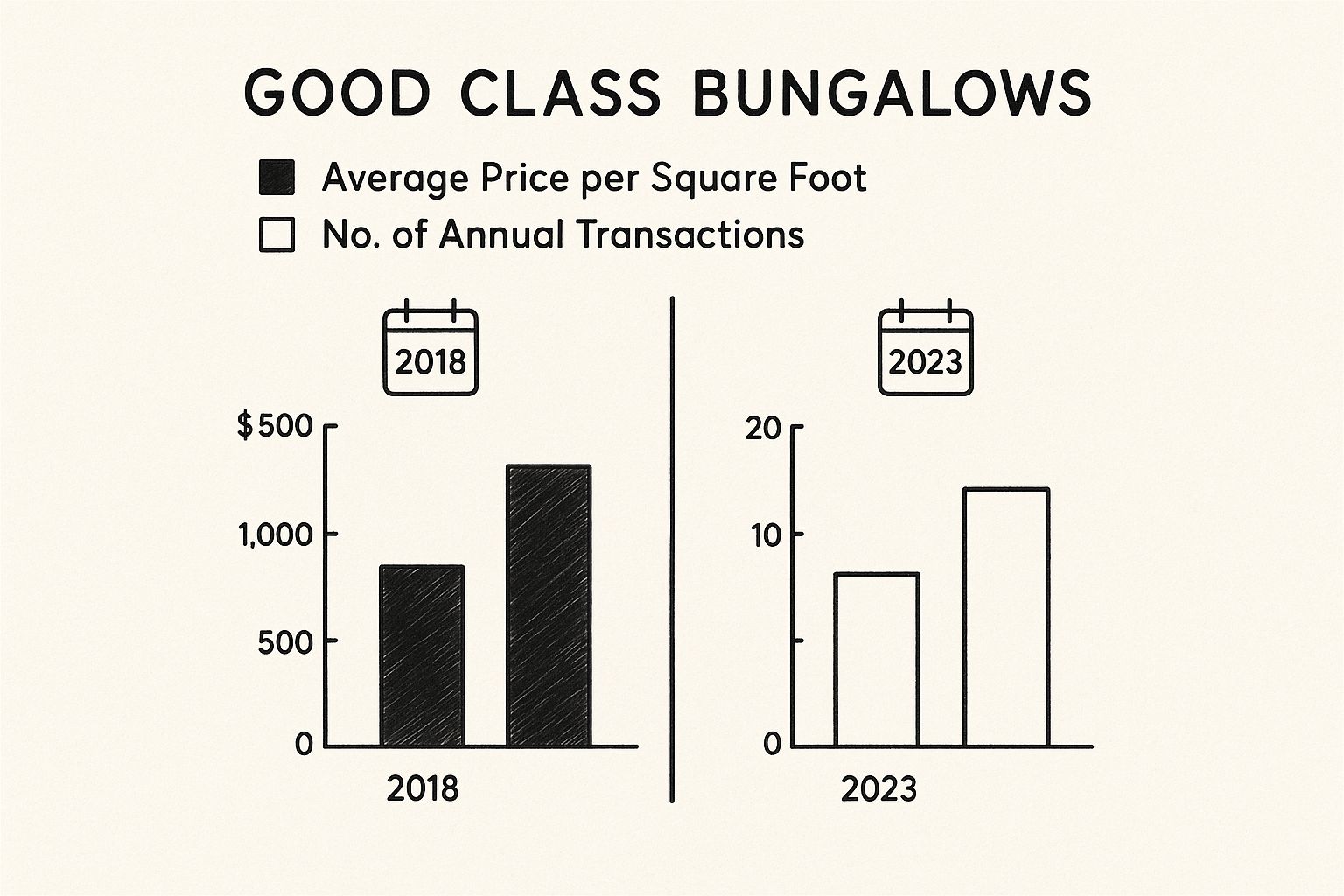
It’s clear from the data that it's not just about the dramatic jump in per-square-foot value. The market has also tightened considerably, with fewer homes changing hands but at much higher price points.
The Lush Greenery of Bukit Timah
Just a little further out, the Bukit Timah cluster offers a more family-focused GCB lifestyle. This area is famous for its proximity to Singapore’s top schools, like Hwa Chong Institution and Nanyang Girls' High School, as well as several prestigious international schools.
Life here is all about being close to nature, with the Bukit Timah Nature Reserve serving as a green lung for the neighbourhood. GCB enclaves like Binjai Park, Yarwood Avenue, and Kilburn Estate are a huge draw for families who want both expansive living space and access to the best education. The atmosphere feels a bit more relaxed and suburban compared to the grand estates around Nassim.
Choosing a Location is Choosing a Lifestyle: The decision between a GCB in Nassim versus one in Bukit Timah really boils down to priorities. One offers unparalleled prestige and city-core proximity, while the other provides a lush, family-friendly environment built around education and nature.
Understanding the Appeal of Different Enclaves
Not all GCBAs are cut from the same cloth; each has a distinct personality that attracts a different kind of buyer. For instance, GCBs in the Caldecott Hill Estate often boast incredible views from their elevated positions, while those in King Albert Park offer a serene, almost resort-like feeling.
To help make sense of it all, here's a look at the different characteristics of these prominent GCB clusters.
Prominent Good Class Bungalow Area Clusters
| District/Cluster | Notable GCB Areas | Key Characteristics |
|---|---|---|
| Districts 10 & 11 (Core Central) | Nassim Road, Cluny Park, Holland Park, Ridout Park, Dalvey Estate | Unrivaled prestige, proximity to Orchard Road and embassies, historical significance, and home to many of Singapore's ultra-wealthy. |
| District 21 (Bukit Timah) | Binjai Park, Kilburn Estate, King Albert Park, Yarwood Avenue | Family-friendly atmosphere, close to top local and international schools, abundant greenery, and a more relaxed, suburban feel. |
| District 20 & 23 (Upper Thomson/Bukit Panjang) | Windsor Park, Chestnut Avenue, Bin Tong Park | Offers a quieter, more secluded lifestyle away from the central hustle, often with larger, undulating plots of land and proximity to nature reserves. |
Ultimately, picking a location for a good class bungalow in Singapore is a deeply personal choice. It's about matching the unique personality of an area—whether it's the old-world charm of Cluny Park or the family-oriented vibe of Binjai Park—with your own vision for the ultimate home and legacy.
Navigating the Rules of GCB Ownership and Development
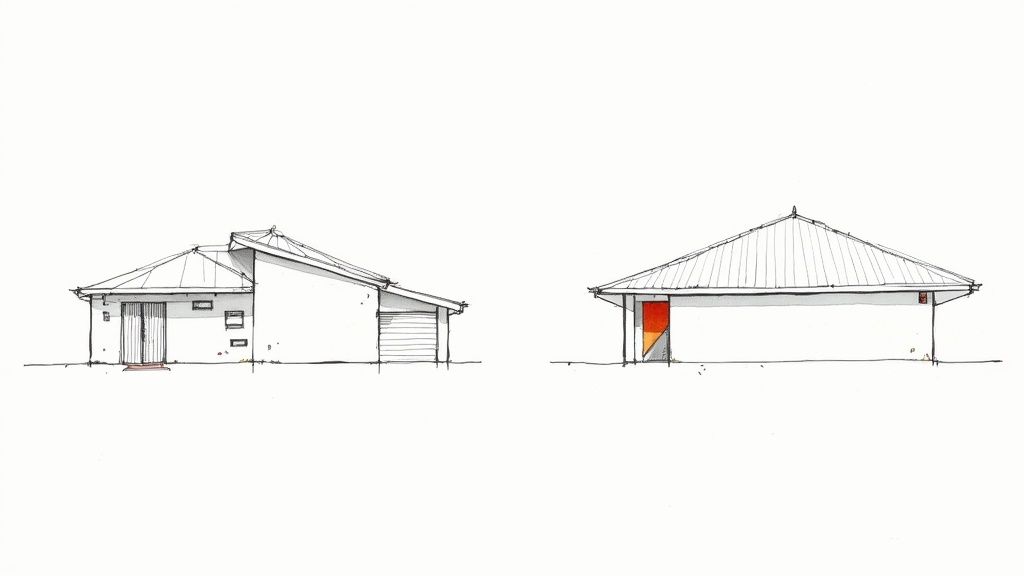
When you step into the world of good class bungalows in Singapore, you’re not just buying a property; you’re entering an exclusive club with a very specific rulebook. These regulations, carefully managed by the Urban Redevelopment Authority (URA), aren't just bureaucratic hurdles. They are the very essence of what makes a GCB a GCB, protecting the prestige, value, and unique character of these homes.
Think of these rules less as restrictions and more as the architecture that upholds the entire GCB ecosystem. For any potential buyer or developer, getting a firm grip on this framework is non-negotiable. It dictates everything from who is even allowed to buy to the exact specifications of what can be built on the land.
It’s these regulations that ensure the 39 designated GCB Areas remain the low-density, green sanctuaries they are today, stopping them from being swallowed up by Singapore's typical high-rise development. Getting it right from the start is crucial to avoid any expensive missteps down the road.
The Pillar of Citizenship Eligibility
The very first, and most significant, rule is all about who can own one. The privilege of owning a Good Class Bungalow is reserved almost exclusively for Singapore Citizens. This isn't just a guideline; it's the primary gatekeeper that ensures these prime landed assets largely remain in local hands.
This strict citizenship requirement immediately shrinks the pool of potential buyers, which in turn reinforces the exclusivity and national significance of GCBs. It turns a simple property purchase into a statement of belonging to one of the country's most elite groups.
For non-citizens, including Singapore Permanent Residents (PRs), the path is incredibly narrow. A PR would need to prove they've made exceptional economic contributions to Singapore and then seek special approval from the Land Dealings Approval Unit (LDAU). Frankly, these approvals are almost unheard of, making citizenship the only truly viable route. This has significant tax implications too, which you can explore further by understanding the Additional Buyer’s Stamp Duty (ABSD) for various buyer profiles.
Strict Planning and Development Controls
So, you’ve cleared the citizenship hurdle. Now, what can you actually do with the land? This is where the URA’s precise planning controls come into play, all designed to preserve the spacious, green character of GCB Areas. These are firm, non-negotiable standards.
The core idea is simple but powerful: champion space and greenery. While most developers aim to maximise every square foot of built-up area, GCB regulations do the exact opposite, ensuring each property feels like a private, sprawling estate.
Here are the key development controls every GCB owner must live by:
- Minimum Plot Size: This is the bedrock rule. Every GCB must be built on a piece of land that is at least 1,400 square metres (that's about 15,070 square feet).
- Maximum Site Coverage: The bungalow itself can only cover up to 40% of the land. This is a deliberate move to ensure a minimum of 60% of the plot is dedicated to open space—think gardens, lawns, and lush landscaping.
- Building Height Limit: To maintain the low-rise, serene atmosphere, GCBs are capped at two storeys high, not including a basement or an attic. No towering mansions here.
Together, these three rules are what create that signature GCB look: a grand, low-slung home nestled in an oasis of green.
Protecting the Neighbourhood Character
Beyond the hard numbers, there are also rules that protect the unique "feel" of each GCB enclave. These are about ensuring any new build or major renovation slots in harmoniously with the existing neighbourhood.
For instance, trying to subdivide a GCB plot is extremely difficult. While you might theoretically be able to split a massive 3,000 sqm plot into two separate GCB-compliant lots, you’d be facing a mountain of red tape and stringent URA approval. The goal is to stop these grand estates from being carved up.
Furthermore, the property must function as a home for a single family. You can’t build a duplex or a collection of smaller houses for different households. This rule is crucial for upholding the low-density promise of GCB living. These regulations collectively act as a protective shield, safeguarding the GCB not just as a luxury home, but as one of Singapore's most enduring and unique asset classes.
What’s Behind the Price Tag? GCBs as a Premier Investment
When you see the eye-watering prices of a good class bungalow in Singapore, it's natural to wonder what justifies the cost. The answer isn't just about luxury; it's a powerful mix of extreme scarcity, relentless demand, and the GCB’s unique role as a legacy asset. These properties are more than just homes—they're strategic tools for preserving wealth, often considered the ultimate safe haven in an unpredictable global economy.
It helps to think of a GCB less like a typical house and more like a rare piece of art or a vintage Ferrari. Its value isn't just about the bricks and mortar. Instead, it's driven by a unique set of forces that create a market with its own rhythm, largely insulated from the ups and downs of the broader property market.
Grasping this dynamic is the key to understanding why GCBs are a cornerstone for building generational wealth. Their performance isn't just about market cycles; it's about a permanent, unresolvable imbalance between supply and demand.
Key Drivers of GCB Valuations
Several core elements come together to create the multi-million-dollar valuation of a GCB. While every property has its own story, the final price is always a blend of tangible and intangible factors that buyers at this level weigh very carefully.
The most critical factor, without a doubt, is land size and location. A sprawling 30,000 sq ft plot in the prestigious Nassim Road enclave will always command a massive premium over a 15,070 sq ft plot in a less central GCB Area. This is the bedrock of its value.
Beyond that, other key drivers come into play:
- Topography and Usability: A perfectly flat, regularly shaped plot of land is a developer's dream and is highly prized. It’s simply easier and more cost-effective to build on. A plot on a steep slope, on the other hand, might offer stunning views but comes with significant architectural and construction headaches.
- Architectural Merit and Age: A home designed by a star architect or a beautifully preserved black-and-white bungalow carries a certain prestige that adds to its price. Similarly, brand-new, move-in-ready bungalows often fetch more than older homes that need a complete overhaul.
- Frontage and Privacy: A property with a wide, impressive frontage and a long driveway creates a grand sense of arrival. This seclusion and presence directly add to its perceived value and exclusivity.
These elements work in concert, creating a valuation that is highly specific to each individual property.
A Historical Fortress for Wealth
Over the years, GCBs have shown remarkable resilience and a strong track record of capital growth. The market is fueled by a simple, unchangeable economic truth: there's a fixed supply of only around 2,800 GCB plots, while the number of ultra-high-net-worth individuals in Singapore and across Asia just keeps climbing.
This fundamental scarcity puts a powerful floor under prices. Even during economic downturns, GCB values tend to hold firm or see only minor dips compared to other assets. Demand from the world's elite—from tech founders to global CEOs—is a constant, as they seek a stable and secure place to park their wealth.
A GCB is often called a "legacy asset" for good reason. It’s not something you buy for a quick flip. These are homes held for decades, passed down through generations as a tangible symbol of a family's success and a bedrock of their fortune.
Transaction data tells a clear story, consistently showing a steady climb in the average price per square foot over the long term. A bungalow bought for $35 million in 2014, like the one at 27 Ridout Road, is worth substantially more today. While the number of sales might fluctuate from year to year, the overall value trajectory has been pointing in one direction: up.
The GCB as a Modern-Day Legacy
Ultimately, the investment value of a good class bungalow in Singapore goes far beyond financial metrics. It represents a piece of carefully preserved heritage, a guarantee of privacy in a bustling city, and a status symbol recognized around the world. Owners aren't just investing in land; they are buying into an exclusive club with a permanent membership cap.
This unique combination ensures that GCBs remain one of the world's most sought-after and stable residential assets. For a broader perspective, you can see how they fit into the bigger picture by exploring our analysis of luxury real estate market trends in Singapore. This context helps cement their role as an essential pillar in any serious wealth preservation strategy.
The Step-by-Step Path to Acquiring a GCB
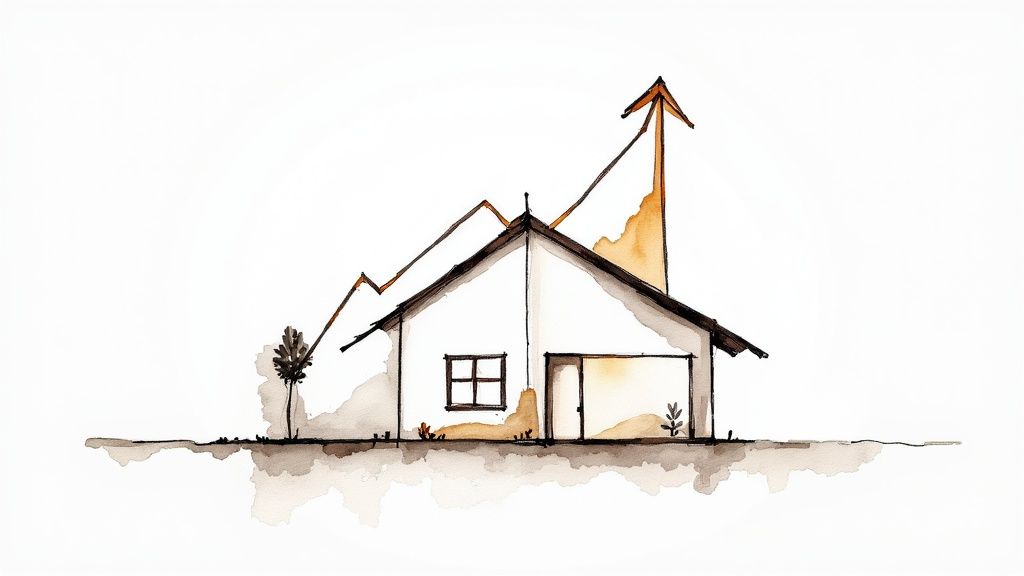
Buying a good class bungalow in Singapore isn't just another property deal; it's a significant strategic move. Think of it less as a simple purchase and more as a major acquisition that demands careful planning, deep market knowledge, and the right team of experts. Let's walk through the essential steps to make this ambition a reality.
The journey doesn't start with property viewings. It starts with building your team. The GCB market is notoriously private, and many of the best homes are never publicly listed. That's why your first, and arguably most important, step is to find a realtor who lives and breathes this ultra-niche segment.
These specialists have the coveted "black book" of off-market properties and trusted relationships within the GCB community. They're more than just agents; they are your strategic advisors, opening doors and providing insights you simply can't get anywhere else.
The Initial Steps: Engagement and Financing
With an expert guide on your side, the next order of business is getting your finances locked down. We're talking about multi-million dollar assets, so this is a far cry from a standard mortgage application.
You'll need to work with private bankers who have experience structuring financing for properties of this magnitude. They'll perform a detailed review of your financial position to issue an Approval-in-Principle (AIP). This document is absolutely vital—it sets your budget and, more importantly, proves to sellers that you are a serious and qualified buyer.
Once your financing is pre-approved, the real search begins. Your agent will start presenting a curated list of GCBs, both on and off-market, that align with everything from your preferred location to the specific characteristics of the land.
Due Diligence and Making Your Offer
Finding the right GCB is a huge milestone, but the work is far from over. Before you make any commitments, a thorough due diligence process is non-negotiable. This is where your legal team steps in.
A good property lawyer will comb through every detail to ensure there are no surprises or hidden liabilities. Their checklist will include:
- Title Search: Confirming clear ownership and making sure there are no legal claims or restrictions on the property.
- URA Compliance: Verifying that the current structure meets all the specific zoning rules and planning controls for a GCB Area.
- Road Line Plans: Checking for any future government projects, like road widening, that could impact the property's boundary or value.
Only after this comprehensive check is complete should you move forward with an offer. This is usually formalised with an "Option to Purchase" (OTP), which involves paying a 1% deposit. This secures the property, typically for 14 days, giving you the window to finalize financing and legal paperwork before exercising the option to buy.
Assembling your "A-team" is non-negotiable for a smooth transaction. This core group should include a specialized GCB realtor, a seasoned property lawyer, an experienced private banker, and a reputable architect if you are considering redevelopment.
The Final Phase: Closing and Future Plans
The final stretch begins when you exercise the OTP and pay the rest of the down payment. Your lawyer takes the lead here, managing all the legal documentation and coordinating with the Singapore Land Authority (SLA) to ensure a flawless transfer of ownership.
This is also when you need to get serious about your vision for the property. Are you planning a simple renovation? A major Addition & Alteration (A&A) project? Or are you looking to tear down and rebuild from scratch? Each option comes with its own set of costs, timelines, and regulations, which is why getting an architect involved early is a smart strategic move.
Answering Your GCB Questions
When you start digging into the world of good class bungalows in Singapore, a few key questions always pop up. Let's tackle some of the most common ones.
Can Foreigners or PRs Actually Buy a GCB?
This is a big one. As a general rule, GCB ownership is reserved exclusively for Singapore Citizens.
There's a small exception, but it's incredibly rare. A Singapore Permanent Resident (PR) who has made truly exceptional economic contributions to the country can apply for special approval from the Land Dealings Approval Unit (LDAU). Don't count on this, though—it's highly unusual and not a typical route to owning one of these prestigious homes.
What Really Separates a GCB from a Regular Bungalow?
It all boils down to two things: location and land size.
A property only earns the GCB title if it meets both of these strict criteria:
- It must be situated within one of the 39 gazetted Good Class Bungalow Areas.
- The land plot must be at least 1,400 square meters (which is about 15,070 sq ft).
A regular bungalow, on the other hand, can be located in other landed housing zones and doesn't have a minimum land size requirement.
Historically, GCBs have proven to be an exceptional store of value with significant long-term capital appreciation. Their extreme scarcity, combined with unwavering demand from ultra-high-net-worth individuals, makes them a resilient and sought-after asset class.
This inherent rarity is what cements their status as a premier asset for preserving wealth across generations.
For those seeking luxury living in Singapore's most coveted district, explore UPPERHOUSE at Orchard Boulevard. Discover bespoke residences with world-class amenities and unparalleled connectivity at https://upperhouse.luxurycondo.sg.
Related Articles
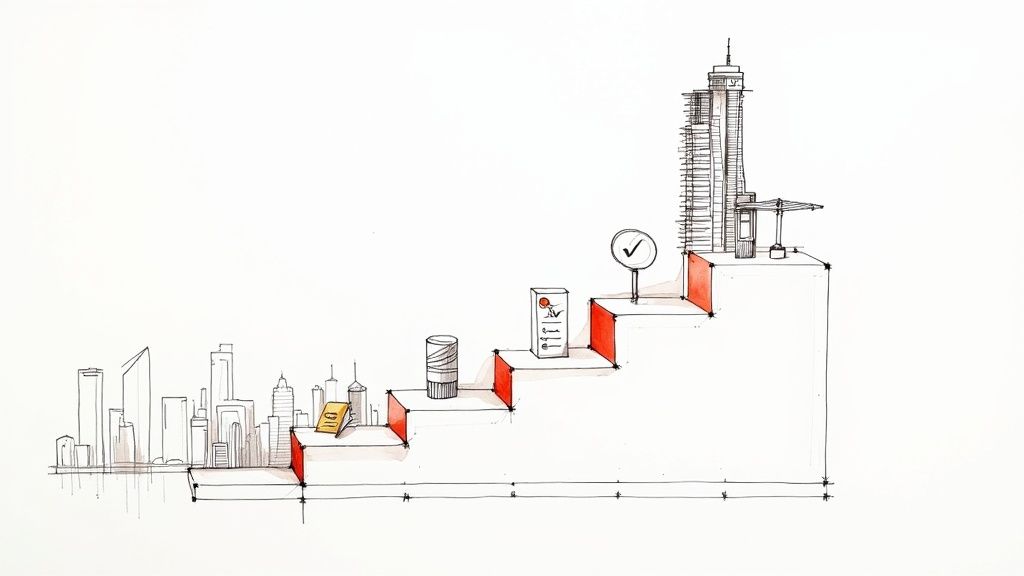
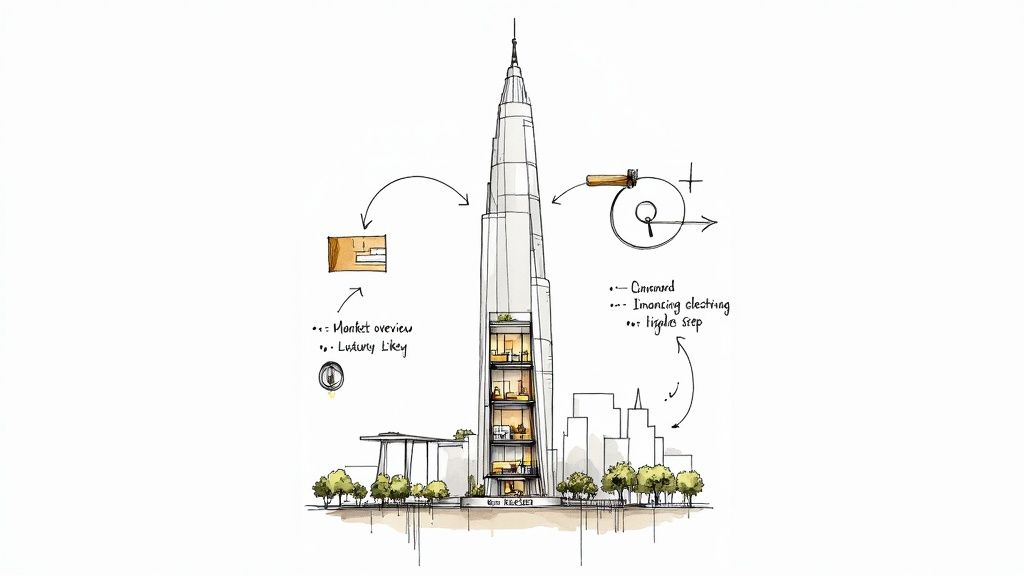
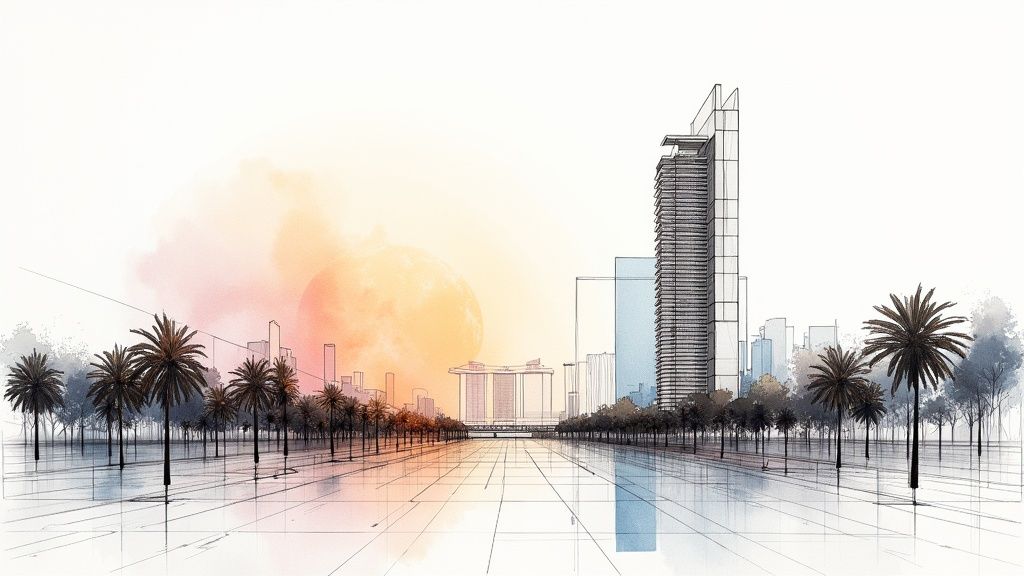
Interested in UPPERHOUSE?
Discover luxury living at UPPERHOUSE at Orchard Boulevard. Get exclusive updates and be the first to know about availability.